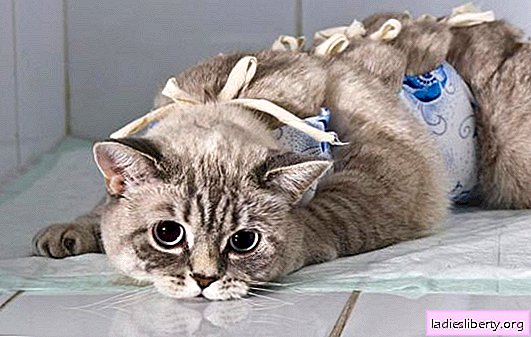
Sterilization avoids health problems and makes life easier for the pet. The procedure should be carried out before the appearance of the first estrus, at the age of 6 months, young cats are relatively easy to tolerate surgery. Sterilization methods have long been worked out, so the owner of the cat has to take care of leaving after the operation and during the recovery period.
Types of Cat Sterilization
Cats are depressed in the following ways:
· Tubal occlusion - ligation of the fallopian tubes, which eliminates the possibility of pregnancy.
· Ovariectomy - removal of only the ovaries, as a result, the estrus disappears from the pet.
· Castration - complete removal of the genitals.
The sterilization operation is not a complicated surgical procedure. Postoperative care for the cat owner is an important and responsible period. Therefore, it is necessary to obtain instructions for the care of the animal after anesthesia from the veterinarian. It is advisable that he show how to properly process the seams, and also tell you what points you should pay attention to.
Transportation home
A cat that has undergone sterilization will need careful and attentive care immediately after the operation. To alleviate the postoperative syndrome, an anesthetic injection is given to the nursery before going home. You should leave the clinic only after making sure that the bleeding has stopped completely. The animal must be transported in a position on its side, so that in case of a reflex eruption, vomit does not disturb breathing. Having delivered home, the sleeping cat needs to be laid on the floor, preferably on the right side, to prevent it from falling from a height after waking up and to facilitate the work of the heart.
In the state of general anesthesia in the animal, the reflex mechanisms of thermoregulation are disturbed, so the temperature in the room must be maintained at least 22 ° C. As a litter, it is necessary to use a well-absorbing diaper so that the cat does not feel severe discomfort in case of involuntary urination. During sleep after anesthesia, the cat's eyes often remain open. In this case, the owner needs to periodically cover them to prevent the cornea from drying out, as well as instill lubricating eye drops on the outer shell.
Precautions after withdrawal from anesthesia
A low-toxic mixture of muscle relaxant with epidural anesthesia, used during sterilization, as well as proper care in the first hours, allows the cat to move around the house a couple of hours after the operation. Increased attention to the pet is required until the recovery of reflexes and normal mobility of the hind limbs. You can’t be allowed to hide in hard-to-reach places where the cat can get stuck and harm itself. It is also undesirable for her to climb onto pieces of furniture from where she can jump. Window panes and windows should be kept closed to prevent the animal from accidentally falling out.
Feeding after sterilization
In the absence of vomiting and special requirements from a veterinarian, the first feeding of a cat is permissible 12 hours after withdrawal from anesthesia. A special diet after sterilization is not required, it is enough to reduce the usual amount of food and water. The bowl from which the animal usually eats should be replaced with a smaller one, and put it 6 cm above the floor so that the collar does not interfere with eating. Feed should be given when the cat shows a desire to eat, full appetite returns within two days after sterilization.
Departure of natural needs after surgery
After the cat leaves the anesthesia, attention must be paid to its natural needs. The cat's urination is less common than the first few days; sometimes a small amount of blood is contained in the discharge. If the pet has a reflex constipation, and she does not visit her tray for three days after anesthesia, a laxative should be used. Stagnation of urine and problems with bowel movements are dangerous to the health of the animal. At first, it is not recommended to use dusty filler for the tray, if necessary, use chopped paper.
Anesthesia and drug support
It is a mistake to assume that the cat does not require analgesia after surgery. Pain after surgery is negligible, so potent painkillers should not be used. Before the restoration of swallowing function, the cat is given injections, and then tablets are given. Taking painkillers helps restore appetite, and normalizes metabolism.
Special care for the cat and antibiotic therapy after sterilization will not be required if during the operation measures have been taken to prevent suppuration, and the necessary wound antiseptics have been taken. Adult animals, as well as those who have undergone surgery, are prescribed vitamins and restorative drugs for better recovery. In case of poor healing of the suture or if internal bleeding is detected, hemostatic therapy is prescribed.
Suture and wound healing
Antiseptic treatment of the suture is a mandatory procedure. The procedure begins to be carried out the day after the operation. Every day, an hour after taking the pain medication, the suture is treated with a cotton swab dipped in chlorhexidine. The incision is cleaned of secretions, Levomekol ointment is applied to the skin around the wound.
Throughout the healing period, it is necessary to ensure the cleanliness and dryness of the postoperative suture. If, as a result of water ingress, the protective crust has softened and the wound is swollen, antibiotics are not allowed to inject themselves. Sutures are removed at a veterinary clinic or independently, no later than 12 days after surgery, so that the threads do not begin to grow into the skin of the animal.
Until the stitches are removed, additional protection must be used, which will not allow the cat to get to the wound. The ties of blankets and collar collar should be tightened tight enough so that the cat could not get rid of them. Protective equipment should be changed in a timely manner if the cat, in an attempt to get to the seams, violates their integrity. Protective equipment used from the moment the operation is completed and proper care of the sutures will provide the cat with quick recovery after sterilization.
For a speedy recovery of a cat after surgery, it is necessary to strictly adhere to all the recommendations of a veterinarian. Care and gentle care will make the pet easier to tolerate stress. If it is not possible to give the cat proper attention after surgery, you should seek help at a veterinary clinic, where there is a service for overexposure after sterilization.











